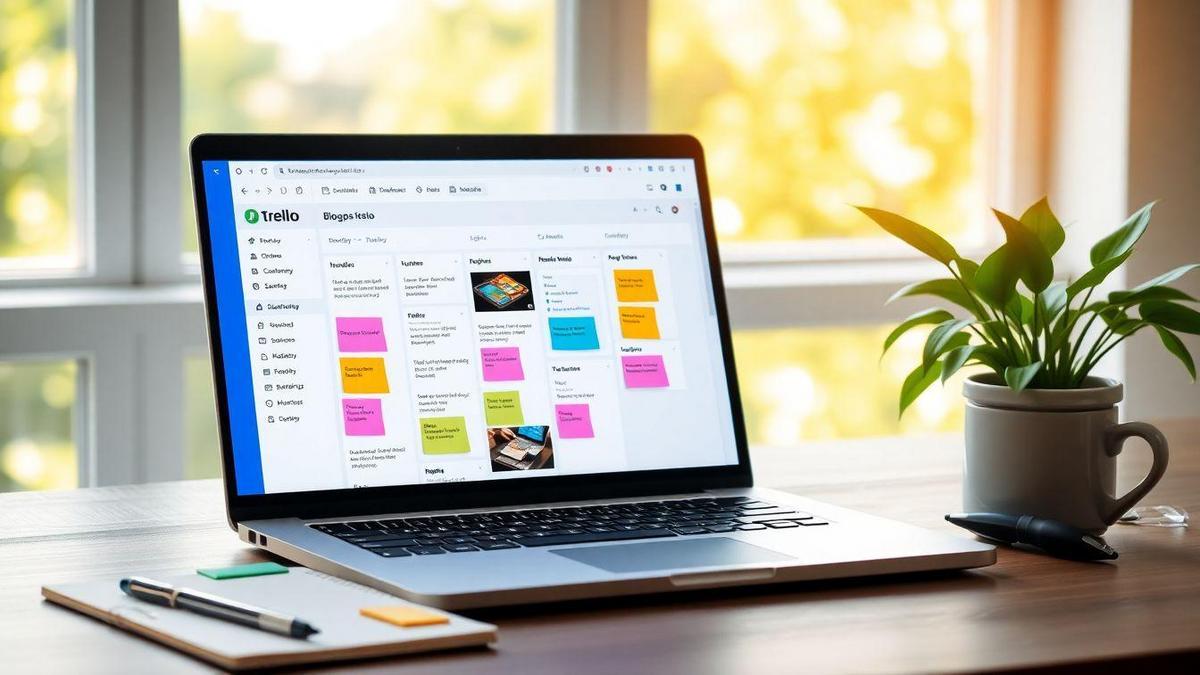Are you ready to learn how to use Trello to organize your editorial calendar? With this handy tool, you can streamline your writing process and stay on top of your content. From setting up your Trello board to tracking your ideas and deadlines, we’ve got you covered! Let’s dive into making your editorial workflow a breeze.

Getting Started with Trello for Your Editorial Calendar
Setting Up Your Trello Board
Ready to dive into Trello? Setting up your board is the first step in organizing your editorial calendar. It’s like laying the foundation for your creative house! Here’s how you can get started:
- Create a New Board: Click on the “Create new board” button. Name it something catchy, like My Editorial Calendar.
- Choose a Background: Pick a fun background to make it visually appealing. A little color can spark creativity!
- Add Lists: Think of lists as the chapters of your story. You might want to create lists like “Ideas,” “In Progress,” and “Published.”
This setup will help you visualize your workflow and keep everything in order.
Choosing the Right Templates
Trello offers a variety of templates that can make your life easier. Why reinvent the wheel when you can use a template that fits your needs? Here are some you might consider:
- Content Calendar: Perfect for planning blog posts or social media updates.
- Editorial Workflow: Great for tracking articles from idea to publication.
- Social Media Planner: Helps schedule posts across different platforms.
You can find these templates in the Trello template gallery. Just search for “editorial calendar,” and you’ll be surprised at what pops up!
Customizing Your Board for Your Needs
Now that you have your board and template, it’s time to make it yours! Customization is key to making Trello work for you. Here’s how to do it:
- Add Labels: Use different colors for various content types. For example, green for blog posts, blue for social media, and orange for newsletters.
- Set Due Dates: Keep track of deadlines by adding due dates to your cards. This way, you won’t miss a beat!
- Create Checklists: Break down tasks into smaller steps. If you’re writing a blog post, your checklist might include brainstorming, drafting, editing, and publishing.
Here’s a simple table to visualize your customization options:
| Customization Option | Purpose |
|---|---|
| Labels | Differentiate content types |
| Due Dates | Track deadlines |
| Checklists | Break tasks into manageable steps |
With these tips, you’ll be all set to use Trello effectively for your editorial calendar.
Organizing Content with Trello
Creating Lists for Different Stages
When you’re using Trello to organize your editorial calendar, creating lists is a great first step. Think of each list as a stage in your content process. You might want to set up lists like:
- Ideas: Where you jot down all your thoughts.
- In Progress: For the pieces you’re currently working on.
- Review: For content that needs a second set of eyes.
- Published: Where you celebrate your completed work!
By organizing your lists this way, you can see exactly where each piece of content stands. It’s like having a bird’s eye view of your entire project!
Using Cards to Track Ideas
Now, let’s talk about cards. Each card in Trello represents a single piece of content. You can create a card for each blog post, article, or social media update.
Here’s how you can make the most of your cards:
- Title: Give each card a clear title.
- Description: Add a short summary of your idea.
- Due Date: Set deadlines to keep yourself on track.
With cards, you can easily move ideas from one list to another. If you’re working on a blog post, just drag it from Ideas to In Progress. It’s as simple as that!
Adding Labels for Easy Identification
To make your workflow even smoother, you can use labels. Labels help you categorize your cards at a glance. You might create labels for:
- Urgent
- Research Needed
- Social Media
- Video Content
This way, you can quickly spot what needs your attention. Imagine looking at your board and instantly knowing which pieces are urgent or require more work. It’s like having a personal assistant right at your fingertips!
| Label | Color |
|---|---|
| Urgent | Red |
| Research Needed | Yellow |
| Social Media | Blue |
| Video Content | Green |
By using lists, cards, and labels, you can transform your editorial calendar into a well-oiled machine. It’s all about making your content creation process as smooth as possible!

Trello Tips for Writers
Setting Deadlines for Your Tasks
When you’re writing, time management can make all the difference. Using Trello, you can set deadlines for each task. This helps keep you on track and makes sure you’re meeting your goals. To set a deadline, just click on a card, find the due date option, and pick a date that works for you.
Imagine you have a big article due next week. Instead of waiting until the last minute, break it down into smaller tasks. Maybe start with research, then outline, and finally, write the draft. Assign a deadline to each task, so you know what needs to be done and when.
Using Checklists to Stay on Track
Checklists are a writer’s best friend. They help you stay organized and make sure you don’t forget any important steps. In Trello, you can add a checklist to any card. Here’s how you can use checklists effectively:
- Break Down Tasks: For each writing project, list all the steps you need to take.
- Mark as Done: As you complete each step, check it off. This gives you a sense of accomplishment.
- Track Progress: It’s satisfying to see how much you’ve completed.
Prioritizing Your Content Ideas
When you have a ton of ideas swirling around, it’s easy to feel overwhelmed. To tackle this, use Trello to prioritize your content ideas. Here’s a simple way to do it:
| Priority Level | Action Item |
|---|---|
| High | Write the leading article |
| Medium | Draft supporting pieces |
| Low | Research future topics |
- High Priority: Focus on writing the most important articles first.
- Medium Priority: Work on supporting pieces that add depth.
- Low Priority: Save research for later; it can wait.
By organizing your ideas this way, you’ll know exactly where to focus your energy.
Managing Your Editorial Schedule with Trello
Creating a Weekly or Monthly View
When you dive into Trello to manage your editorial calendar, the first step is to create a clear view of your tasks. You can set up a weekly or monthly board that shows what you need to do at a glance.
- Create Lists: Start by making lists for each week or month. Label them clearly, like “Week 1,” “Week 2,” or “October.”
- Add Cards: Under each list, add cards for each task or piece of content. For example, you might have cards for “Blog Post Ideas,” “Drafting,” and “Editing.”
- Use Labels: Color-code your cards! This helps you quickly see what’s urgent or what needs your attention.
Syncing Trello with Your Calendar
Want to keep everything in sync? Connecting Trello with your calendar can be a game changer. Here’s how to do it:
- Power-Ups: Use Trello’s Power-Ups to link your calendar. This feature lets you see your Trello tasks in your Google Calendar or Outlook.
- Due Dates: Always set due dates for your cards. This way, when you check your calendar, you can see what’s coming up and plan your time accordingly.
Adjusting Your Schedule as Needed
Life happens, and sometimes your editorial calendar needs a little tweaking. Here’s how to adjust:
- Drag and Drop: Trello makes it easy! If a task needs to move to next week, just drag the card to the new list.
- Check-In Regularly: Make it a habit to review your calendar weekly. This helps you catch any tasks that are falling behind.
| Task | Due Date | Status |
|---|---|---|
| Blog Post 1 | 10/05/2023 | In Progress |
| Blog Post 2 | 10/12/2023 | Not Started |
| Newsletter | 10/15/2023 | Completed |
By using Trello effectively, you can keep your editorial calendar organized and on track.

Using Trello for Blogging
Planning Blog Posts Ahead of Time
When you think about planning blog posts, Trello can be your best buddy. It’s like having a digital corkboard where you can pin your ideas. Start by creating a board just for your blog. You can have lists for Ideas, In Progress, and Published.
Here’s a simple way to set it up:
| List Name | Purpose |
|---|---|
| Ideas | Jot down all your blog ideas. |
| In Progress | Posts you’re currently writing. |
| Published | Finished posts ready to share. |
When you have an idea, just create a card in the Ideas list. You can add due dates, checklists, and even labels to categorize your posts. This way, you’ll always know what’s cooking in your blogging kitchen!
Collaborating with Guest Writers
If you’re looking to collaborate with guest writers, Trello makes it easy. You can invite them to your board. Each guest writer can have their own card for their post. This keeps things neat and tidy.
Here’s how you can set it up:
- Create a card for each guest writer.
- Add details like deadlines and topics.
- Use comments for feedback and discussions.
This way, everyone stays on the same page. No more lost emails or mixed messages!
Tracking Post Performance in Trello
Once your posts are live, tracking their performance is crucial. You can use Trello to keep tabs on how each post is doing. Create a checklist on each card to monitor metrics like views, shares, and comments.
Here’s a quick example of what that checklist might look like:
| Metric | Status |
|---|---|
| Views | 500 |
| Shares | 50 |
| Comments | 20 |
This simple setup helps you see which posts are hitting the mark and which ones might need a little more love.
Collaborative Editorial Calendar with Trello
Inviting Team Members to Your Board
Getting your team on board with your Trello calendar is as easy as pie! First, open your Trello board and look for the “Invite” button. Click on that, and you can enter the email addresses of your teammates. They’ll receive an invitation to join. Once they accept, they’ll be able to see everything you’ve set up. It’s like throwing a party and making sure everyone gets the invite!
Assigning Tasks to Different Writers
Now that your team is in, it’s time to get down to business. You can assign tasks to different writers by creating cards for each assignment. Each card can represent a blog post, article, or any content piece. Just click on the card, and you’ll find an option to add members. Select the writer you want to assign and voilà! They’ll get a notification, and you can track who’s doing what.
Here’s a quick table to help you visualize it:
| Task | Assigned To | Due Date |
|---|---|---|
| Blog Post 1 | Sarah Johnson | 10/15/2023 |
| Article 2 | Mike Thompson | 10/20/2023 |
| Social Media | Emily Davis | 10/18/2023 |
Communicating Effectively within Trello
Communication is key! Use the comment section on each card to discuss ideas, ask questions, or give feedback. It’s like having a chat right where the work is happening. You can tag team members by using @ followed by their name, so they know you’re talking to them. This keeps everyone in the loop and makes sure no one misses important updates.
Remember, keeping it clear and friendly goes a long way. If you need to share files or links, you can attach them directly to the card. This way, everything stays organized and easy to find.

Editorial Workflow with Trello Board
Streamlining Your Content Creation Process
Using Trello to organize your editorial calendar can make your content creation process smoother than ever. Imagine having a clear view of what needs to be done, who’s doing it, and when it’s due. With Trello, you can create a board that visually organizes your tasks.
Start by setting up lists for each stage of your workflow. For example, you might have:
- Ideas: Where you jot down all your content ideas.
- In Progress: For pieces you’re currently working on.
- Review: For items waiting for feedback.
- Published: To celebrate your completed work!
This setup helps you keep track of everything at a glance. Plus, you can drag and drop cards between lists as you progress. It’s like moving pieces on a chessboard, making sure you’re always a step ahead.
Reviewing and Editing Content in Trello
Once you’ve got your content drafted, it’s time to dive into the reviewing and editing phase. Trello makes this easy with its comment feature. You can leave feedback directly on the card, making sure everyone is on the same page.
Here’s how you can enhance your review process:
- Add Checklists: Create a checklist for editing tasks. This could include grammar checks, SEO optimization, and formatting.
- Assign Team Members: If you’re working with others, assign specific tasks to them. For instance, one person can focus on SEO while another checks for clarity.
- Use Labels: Color-code your cards to signify the status of each piece. For example, green for “ready for publishing,” yellow for “needs edits,” and red for “major changes needed.”
Finalizing Posts Before Publishing
Before hitting that publish button, make sure everything is polished. Trello allows you to set due dates, so you can keep track of deadlines and avoid last-minute scrambles.
Here’s a simple checklist to follow before you finalize your posts:
| Task | Completed |
|---|---|
| Proofread for errors | [ ] |
| Optimize for SEO | [ ] |
| Confirm images are ready | [ ] |
| Schedule for publishing | [ ] |
With this checklist in hand, you’ll be ready to publish with confidence. Using Trello not only keeps your workflow organized but also makes the entire process feel less overwhelming.
Trello Organization Strategies
Using Power-Ups to Enhance Functionality
Power-Ups are like the cherry on top of your Trello sundae. They add extra features that can really boost your productivity. Imagine being able to integrate your favorite apps directly into your Trello boards. With Power-Ups, you can do just that!
Here are some popular Power-Ups you might want to check out:
| Power-Up | Description |
|---|---|
| Calendar | Syncs due dates with your calendar. |
| Google Drive | Attach files directly from Google Drive. |
| Slack | Get notifications in your Slack channel. |
| Custom Fields | Add extra information to your cards. |
Using these Power-Ups can help you keep everything in one place. This means less time switching between apps and more time getting things done!
Integrating Other Tools with Trello
Integrating other tools with Trello can make your workflow smoother than butter on warm toast. You can connect tools like Google Drive, Slack, or even Zapier to automate tasks.
For example, you can set up a Zap that automatically creates a Trello card whenever you receive a new email. This way, you won’t miss any important tasks. Just think of it as having a personal assistant who never sleeps!
Keeping Your Board Clean and Efficient
A cluttered board can feel like a messy room. You know you can’t find anything when it’s all over the place! To keep your Trello board clean, try these tips:
- Regularly Archive Cards: Once a task is done, archive it. This keeps your board focused on what’s important.
- Use Labels Wisely: Color-code your tasks to easily identify what needs your attention.
- Limit Active Cards: Focus on a few tasks at a time. This helps avoid feeling overwhelmed.
By keeping your board tidy, you’ll find it easier to see what’s next on your list.

Tracking Progress with Trello
Monitoring Your Editorial Goals
When you think about keeping track of your editorial goals, Trello is like your trusty sidekick. It’s easy to set up boards for each project, and you can add cards for every task. This way, you can see what’s on your plate at a glance.
Imagine having columns like “To Do,” “In Progress,” and “Done.” You can simply drag and drop tasks as you make progress. This visual approach helps you stay on top of your goals and makes it clear what needs your attention. Plus, you can add due dates and checklists to each card, which keeps everything organized and on track.
Analyzing Completed Tasks for Improvement
Once you’ve wrapped up some tasks, take a moment to look back. Analyzing completed tasks can show you what worked and what didn’t. Did you finish a project ahead of schedule? Great! What did you do differently? On the flip side, if something took longer than expected, think about why that happened.
You can create a table to summarize your findings:
| Task | Time Taken | What Went Well | What Needs Improvement |
|---|---|---|---|
| Blog Post | 3 days | Clear outline helped | Need better research |
| Social Media Update | 1 day | Engaging content | Plan posts in advance |
This reflection helps you learn and adjust your approach for the next time.
Celebrating Milestones with Your Team
Don’t forget to celebrate milestones with your team! Hitting a big goal is an achievement worth recognizing. Maybe you could have a small gathering or send out a fun team email. Acknowledging these moments builds morale and keeps everyone motivated.
You might even create a Celebration Board on Trello. Add cards for each milestone and include a fun image or a note about what was achieved. This not only highlights your hard work but also keeps the spirit high for future projects.
Frequently asked questions
How can Trello help me with my editorial calendar?
Trello keeps your tasks neat. You can see everything at a glance. Add cards for each article, set deadlines, and assign tasks to your team.
How do I create a board for my editorial calendar?
Just click on Create Board. Give it a fun name. You can set lists like Ideas, In Progress, and Published. It’s that easy!
Can I use labels in Trello for my editorial calendar?
Absolutely! You can use labels to color-code your content type. For example, blue for blog posts, green for social media, and red for videos.
How do I add due dates to my cards?
Open the card and look for the “Due Date” option. Click it, choose your date, and hit save. You’ll get reminders too!
What is the best way to track progress in Trello?
Use the checklist feature on your cards. As you complete tasks, check them off! This way, you see your progress in real-time.

Lucas is a technical SEO expert who has optimized over 200 websites and managed Google AdSense and Ad Manager campaigns since 2016. At ReviewWebmaster.com, he shares strategies to boost organic traffic and monetize every single visit.
Types of articles he writes:
-
“How to Increase Your Blog’s RPM with Simple Tweaks”
-
“Technical SEO Checklist for WordPress Sites”
-
“Complete Beginner’s Guide to Google Ad Manager”
Why it works:
Lucas brings a confident, analytical, and performance-driven voice to the site — perfect for readers looking for actionable, results-oriented content.
